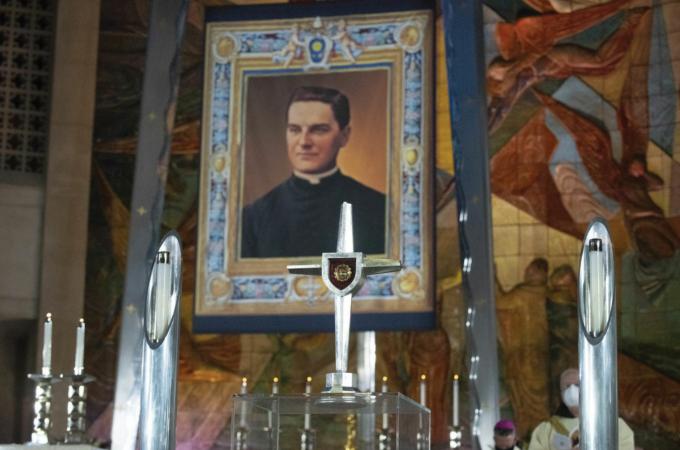From Cardinal Seán's blog
On Saturday, I traveled to Hartford to participate in the Beatification Mass for Blessed Father Michael J. McGivney, the founder of the Knights of Columbus.
The beatification was held at Hartford's Cathedral of St. Joseph. It was certainly disappointing not to be able to have a large beatification ceremony, such as the one that was held in Detroit for Blessed Solanus Casey, where they filled a stadium with something like 80,000 people. But, of course, because of the pandemic, there was a very limited group allowed in the cathedral. The cathedral is very large but, with social distancing, attendance was limited to only about 200 people, and a large percentage of those were parish priests who were concelebrating.
Cardinal Timothy Dolan of New York, Cardinal Joseph Tobin of Newark, and myself were the three cardinals present, and there were also a number of bishops, including the local archbishop, Leonard Blair. The principal concelebrant was Cardinal Tobin, who was the representative of the Holy Father. He gave a beautiful homily and reflection on the life of Blessed Father Michael McGivney.
After Cardinal Tobin read the decree in Latin, Archbishop William Lori of Baltimore, who is the Supreme Chaplain of the Knights of Columbus, read the English translation of the decree.
One of the more touching moments of the Mass was when young Mikey Schachle, who experienced a miraculous healing through the intercession of Blessed Father McGivney, presented one of the relics to Cardinal Tobin. I think we were all very touched by that.
During the Mass, Supreme Knight Carl Anderson also offered a short biographical sketch of Father McGivney.
One detail of his life that I had forgotten was that Father McGivney died during a pandemic at 38 years of age. He was the oldest of 13 children and, before going to the seminary, worked in the same factory where his father had worked. In his life as a parish priest, he was very much dedicated to the immigrant population -- mainly from Ireland at that time -- and the founding of the Knights of Columbus was very much a way of trying to help that immigrant population to be strong in their Catholic faith and also have the material benefits that an insurance program would bring to them. So, he was very concerned about both the spiritual and material needs of his people.
All Saints Day
Sunday was, of course, All Saints Day, and I celebrated the Spanish Mass at the cathedral that morning. November always begins with All Saints and All Souls -- days in which the Church, through the liturgy, reminds us of our brothers and sisters who are in the Church Triumphant and the Church Suffering, and that we are part of this same community of faith.
In my reflection at the Mass, I talked about the Tomb of the Unknown Soldier and said that our celebration of All Saints is something akin to that -- a day when we celebrate our brothers and sisters who are part of that great cloud of witnesses but were not necessarily formally canonized. Rather, they are people who lived their baptismal commitment and their faith in such a way that they grew in love for God and holiness and are now in eternity in the presence of God. Pope Francis speaks about "the saints next door." Well, on All Saints Day, we celebrate those very "saints next door" -- our grandparents, godparents, neighbors, and others who have gone before us marked with the sign of faith, who lived faith-filled lives of missionary discipleship and who now are in God's presence for all eternity.
All Souls Day
Monday was, of course, All Souls, and it is such a privilege for a priest to be able to celebrate three Masses on that day. The older I get, the more people I know who have passed into eternity -- friends, relatives, and clergy. So, it's wonderful to have the three All Souls Day Masses to pray for all of our beloved dead.



















